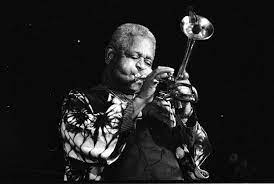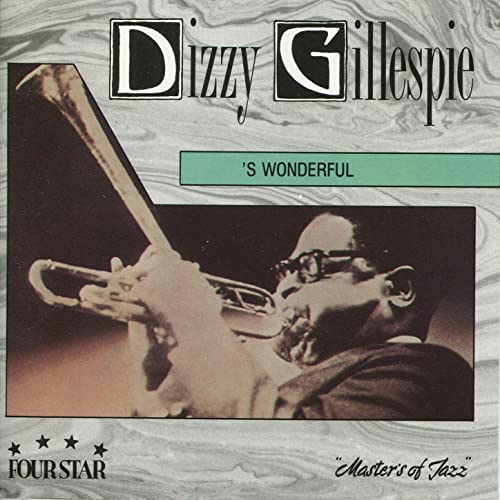
Gillespie, Dizzy
John Birks “Dizzy” Gillespie ( October 21, 1917 – January 6, 1993) was an American jazz trumpeter, bandleader, composer, educator and singer. He was a trumpet virtuoso and improviser, building on the virtuoso style of Roy Eldridge but adding layers of harmonic and rhythmic complexity previously unheard in jazz. His combination of musicianship, showmanship, and wit made him a leading popularizer of the new music called bebop. His beret and horn-rimmed spectacles, scat singing, bent horn, pouched cheeks, and light-hearted personality provided some of bebop’s most prominent symbols.
In the 1940s Gillespie, with Charlie Parker, became a major figure in the development of bebop and modern jazz. He taught and influenced many other musicians, including trumpeters Miles Davis, Jon Faddis, Fats Navarro, Clifford Brown, Arturo Sandoval, Lee Morgan, Chuck Mangione, and balladeer Johnny Hartman.
Scott Yanow wrote, “Dizzy Gillespie’s contributions to jazz were huge. One of the greatest jazz trumpeters of all time, Gillespie was such a complex player that his contemporaries ended up being similar to those of Miles Davis and Fats Navarro instead, and it was not until Jon Faddis’s emergence in the 1970s that Dizzy’s style was successfully recreated [….] Gillespie is remembered, by both critics and fans alike, as one of the greatest jazz trumpeters of all time”.
Bebop was known as the first modern jazz style. However, it was unpopular in the beginning and was not viewed as positively as swing music was. Bebop was seen as an outgrowth of swing, not a revolution. Swing introduced a diversity of new musicians in the bebop era like Charlie Parker, Thelonious Monk, Bud Powell, Kenny Clarke, Oscar Pettiford, and Gillespie. Through these musicians, a new vocabulary of musical phrases was created. With Parker, Gillespie jammed at famous jazz clubs like Minton’s Playhouse and Monroe’s Uptown House. Parker’s system also held methods of adding chords to existing chord progressions and implying additional chords within the improvised lines
Gillespie compositions like “Groovin’ High“, “Woody ‘n’ You“, and “Salt Peanuts” sounded radically different, harmonically and rhythmically, from the swing music popular at the time. “A Night in Tunisia“, written in 1942, while he was playing with Earl Hines’ band, is noted for having a feature that is common in today’s music: a syncopated bass line. “Woody ‘n’ You” was recorded in a session led by Coleman Hawkins with Gillespie as a featured sideman on February 16, 1944 (Apollo), the first formal recording of bebop. He appeared in recordings by the Billy Eckstine band and started recording prolifically as a leader and sideman in early 1945. He was not content to let bebop sit in a niche of small groups in small clubs. A concert by one of his small groups in New York’s Town Hall on June 22, 1945 presented bebop to a broad audience; recordings of it were released in 2005. He started to organize big bands in late 1945. Dizzy Gillespie and his Bebop Six, which included Parker, started an extended gig at Billy Berg’s club in Los Angeles in December 1945. Reception was mixed and the band broke up. In February 1946 he signed a contract with Bluebird, gaining the distribution power of RCA for his music. He and his big band headlined the 1946 film Jivin’ in Be-Bop.
His big bands of the late 1940s also featured Cuban rumberos Chano Pozo and Sabu Martinez, sparking interest in Afro-Cuban jazz. He appeared frequently as a soloist with Norman Granz‘s Jazz at the Philharmonic.
Gillespie and his Bee Bop Orchestra was the featured star of the 4th Cavalcade of Jazz concert held at Wrigley Field in Los Angeles which was produced by Leon Hefflin, Sr. on September 12, 1948. The young maestro had recently returned from Europe where his music rocked the continent. The program description noted “the musicianship, inventive technique, and daring of this young man has created a new style, which can be defined as off the chord solo gymnastics.” Also on the program that day were Frankie Laine, Little Miss Cornshucks, The Sweethearts of Rhythm, The Honeydrippers, Big Joe Turner, Jimmy Witherspoon, The Blenders, and The Sensations.
In 1948, Gillespie was involved in a traffic accident when the bicycle he was riding was bumped by an automobile. He was slightly injured and found that he could no longer hit the B-flat above high C. He won the case, but the jury awarded him only $1000 in view of his high earnings up to that point.
In 1951, Gillespie founded his record label, Dee Gee Records; it closed in 1953.
On January 6, 1953, he threw a party for his wife Lorraine at Snookie’s, a club in Manhattan, where his trumpet’s bell got bent upward in an accident, but he liked the sound so much he had a special trumpet made with a 45 degree raised bell, becoming his trademark.
In 1956 Gillespie organized a band to go on a State Department tour of the Middle East which was well-received internationally and earned him the nickname “the Ambassador of Jazz”. During this time, he also continued to lead a big band that performed throughout the United States and featured musicians including Pee Wee Moore and others. This band recorded a live album at the 1957 Newport jazz festival that featured Mary Lou Williams as a guest artist on piano.
In the late 1940s, Gillespie was involved in the movement called Afro-Cuban music, bringing Afro-Latin American music and elements to greater prominence in jazz and even pop music, particularly salsa. Afro-Cuban jazz is based on traditional Afro-Cuban rhythms. Gillespie was introduced to Chano Pozo in 1947 by Mario Bauza, a Latin jazz trumpet player. Chano Pozo became Gillespie’s conga drummer for his band. Gillespie also worked with Mario Bauza in New York jazz clubs on 52nd Street and several famous dance clubs such as the Palladium and the Apollo Theater in Harlem. They played together in the Chick Webb band and Cab Calloway’s band, where Gillespie and Bauza became lifelong friends. Gillespie helped develop and mature the Afro-Cuban jazz style. Afro-Cuban jazz was considered bebop-oriented, and some musicians classified it as a modern style. Afro-Cuban jazz was successful because it never decreased in popularity and it always attracted people to dance.
Gillespie’s most famous contributions to Afro-Cuban music are “Manteca” and “Tin Tin Deo” (both co-written with Chano Pozo); he was responsible for commissioning George Russell‘s “Cubano Be, Cubano Bop”, which featured Pozo. In 1977, Gillespie met Arturo Sandoval during a jazz cruise to Havana. Sandoval toured with Gillespie and defected in Rome in 1990 while touring with Gillespie and the United Nations Orchestra.
In the 1980s, Gillespie led the United Nations Orchestra. For three years Flora Purim toured with the Orchestra. She credits Gillespie with improving her understanding of jazz.
In 1982, he was sought out by Motown musician Stevie Wonder to play his solo in Wonder’s 1982 hit single, “Do I Do“.
He starred in the film The Winter in Lisbon that was released as El invierno en Lisboa in 1992 and re-released in 2004.[35] The soundtrack album, featuring him, was recorded in 1990 and released in 1991. The film is a crime drama about a jazz pianist who falls for a dangerous woman while in Portugal with an American expatriate’s jazz band.
In December 1991, during an engagement at Kimball’s East in Emeryville, California, he suffered a crisis from what turned out to be pancreatic cancer. He performed one more night but cancelled the rest of the tour for medical reasons, ending his 56-year touring career. He led his last recording session on January 25, 1992.
On November 26, 1992, Carnegie Hall, following the Second Baháʼí World Congress, celebrated Gillespie’s 75th birthday concert and his offering to the celebration of the centenary of the passing of Baháʼu’lláh. Gillespie was to appear at Carnegie Hall for the 33rd time. The line-up included Jon Faddis, James Moody, Paquito D’Rivera, and the Mike Longo Trio with Ben Brown on bass and Mickey Roker on drums. Gillespie was too unwell to attend. “But the musicians played their real hearts out for him, no doubt suspecting that he would not play again. Each musician gave tribute to their friend, this great soul and innovator in the world of jazz.”
A longtime resident of Englewood, New Jersey, Gillespie died of pancreatic cancer on January 6, 1993, at the age of 75 and was buried in Flushing Cemetery, Queens, New York City. Mike Longo delivered a eulogy at his funeral.
